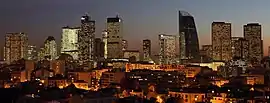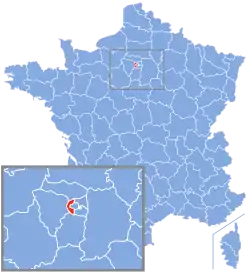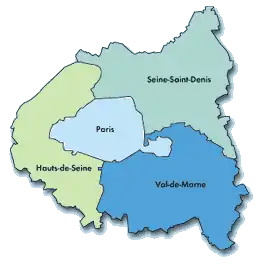Hauts-de-Seine
Hauts-de-Seine (/oʊ də seɪn/, French: [o.də.sɛn] (![]() listen); lit. 'Seine Heights') is a department of France located in the region of Île-de-France. It is part of Grand Paris as it covers the western inner suburbs of Paris. With a population of 1,603,268 (as of 2016) and a total area of 176 square kilometres (68 square miles), it is the second-most highly densely populated department of France. Hauts-de-Seine is best known for containing the modern office, theatre and shopping complex La Défense. Its inhabitants are called Altoséquanais.
listen); lit. 'Seine Heights') is a department of France located in the region of Île-de-France. It is part of Grand Paris as it covers the western inner suburbs of Paris. With a population of 1,603,268 (as of 2016) and a total area of 176 square kilometres (68 square miles), it is the second-most highly densely populated department of France. Hauts-de-Seine is best known for containing the modern office, theatre and shopping complex La Défense. Its inhabitants are called Altoséquanais.
Hauts-de-Seine | |
|---|---|
 .jpg.webp) .jpg.webp)   From top down, left to right: a view of Boulogne-Billancourt from the Parc de Saint-Cloud, the Château de Sceaux, Meudon site of the Paris Observatory, La Défense seen from La Garenne-Colombes, as well as the Château de Malmaison | |
 Flag  Coat of arms | |
 Location of Hauts-de-Seine in France | |
| Coordinates: 48°50′N 02°12′E | |
| Country | France |
| Region | Île-de-France |
| Prefecture | Nanterre |
| Subprefectures | Antony Boulogne- Billancourt |
| Government | |
| • President of the Departmental Council | Georges Siffredi (LR, interim) |
| Area | |
| • Total | 176 km2 (68 sq mi) |
| Population (2016) | |
| • Total | 1,603,268 |
| • Rank | 5th |
| • Density | 9,100/km2 (24,000/sq mi) |
| Time zone | UTC+1 (CET) |
| • Summer (DST) | UTC+2 (CEST) |
| Department number | 92 |
| Arrondissements | 3 |
| Cantons | 23 |
| Communes | 36 |
| ^1 French Land Register data, which exclude estuaries, and lakes, ponds, and glaciers larger than 1 km2 | |
Hauts-de-Seine is considered to be the wealthiest department in France, and additionally has the highest GDP per capita at €104,000 in 2016.[1]
Geography
Hauts-de-Seine and two other small départements, Seine-Saint-Denis and Val-de-Marne, form a ring around Paris, known as the Petite Couronne (literal translation: "little crown") and are together with the City of Paris included in Greater Paris since 1 January 2016.

Administration

Hauts-de-Seine is made up of three departmental arrondissements and 36 communes:
Government
Hauts-de-Seine has a general council of which members are called general councillors. The general council is the deliberative organ of the department. The general councilors are elected by the inhabitants of the departement for a 6-years term. The general council is ruled by a president.
History
The Hauts-de-Seine department was created in 1968, from parts of the former départements of Seine and Seine-et-Oise. Its creation reflected the implementation of a law passed in 1964, and Nanterre had already been selected as the prefecture for the new department early in 1965.
In the 1990s and early 2000s, Hauts-de-Seine received national attention as the result of a corruption scandal concerning the misuse of public funds provided for the department's housing projects. Implicated were former minister and former president of the Hauts-de-Seine General Council, Charles Pasqua, and other personalities of the RPR party. (See corruption scandals in the Paris region.)
Economy
Hauts-de-Seine is France's wealthiest département and one of Europe's richest areas. Its GDP per capita was €104,000 in 2016, according to Eurostat official figures.[1]
Politics
Hauts-de-Seine was the political base of Nicolas Sarkozy, President of the Republic from 2007 to 2012. He was previously the Mayor of Neuilly-sur-Seine (1983–2002) and President of the Departmental Council of Hauts-de-Seine (2004–2007). He succeeded Charles Pasqua as Departmental Council President.[2]
Members of the National Assembly
Hauts-de-Seine elected the following members of the National Assembly during the 2017 legislative election:
Demographics
Population development since 1881:
| Year | Pop. | ±% p.a. |
|---|---|---|
| 1881 | 254,928 | — |
| 1891 | 332,076 | +2.68% |
| 1901 | 467,391 | +3.48% |
| 1911 | 614,862 | +2.78% |
| 1921 | 724,261 | +1.65% |
| 1931 | 949,231 | +2.74% |
| 1936 | 1,019,627 | +1.44% |
| 1946 | 992,859 | −0.27% |
| 1954 | 1,118,020 | +1.50% |
| 1962 | 1,381,805 | +2.68% |
| 1968 | 1,461,619 | +0.94% |
| 1975 | 1,438,930 | −0.22% |
| 1982 | 1,387,039 | −0.52% |
| 1990 | 1,391,658 | +0.04% |
| 1999 | 1,428,881 | +0.29% |
| 2006 | 1,536,100 | +1.04% |
| 2011 | 1,581,268 | +0.58% |
| 2016 | 1,603,268 | +0.28% |
| source:[4] | ||
Place of birth of residents
| Born in Metropolitan France | Born outside Metropolitan France | |||
|---|---|---|---|---|
| 80.6% | 19.4% | |||
| Born in Overseas France |
Born in foreign countries with French citizenship at birth1 | EU-15 immigrants2 | Non-EU-15 immigrants | |
| 1.5% | 3.5% | 3.8% | 10.6% | |
| 1 This group is made up largely of former French settlers, such as pieds-noirs in Northwest Africa, followed by former colonial citizens who had French citizenship at birth (such as was often the case for the native elite in French colonies), and to a lesser extent foreign-born children of French expatriates. Note that a foreign country is understood as a country not part of France in 1999, so a person born for example in 1950 in Algeria, when Algeria was an integral part of France, is nonetheless listed as a person born in a foreign country in French statistics. 2 An immigrant is a person born in a foreign country not having French citizenship at birth. Note that an immigrant may have acquired French citizenship since moving to France, but is still considered an immigrant in French statistics. On the other hand, persons born in France with foreign citizenship (the children of immigrants) are not listed as immigrants. | ||||
Tourism
 Empress Joséphine's bedroom at the Château de Malmaison
Empress Joséphine's bedroom at the Château de Malmaison Paris seen from the Parc de Saint-Cloud
Paris seen from the Parc de Saint-Cloud
References
External links
- (in French) Website of the General council
- (in French) Prefecture website